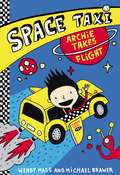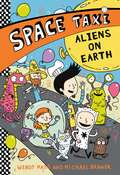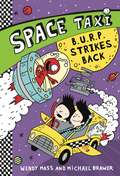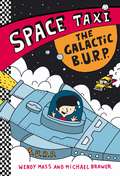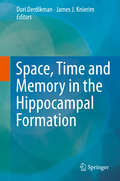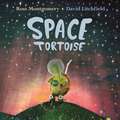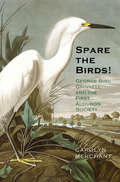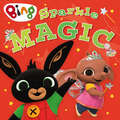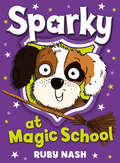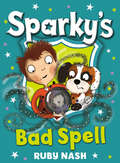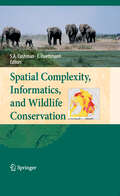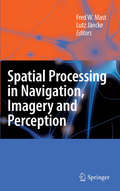- Table View
- List View
Space Taxi: Archie Takes Flight (Space Taxi #1)
by Wendy Mass Michael BrawerArchie Morningstar learns a big family secret and helps save the universe. All before breakfast! It's not every day a regular kid like Archie gets to wake up at midnight. But today is Take Your Kid to Work Day, and Archie is finally allowed to ride along in his dad's taxi cab. He has been waiting eight years, eight months, and eight days for this moment to arrive. But he's about to discover his dad is no ordinary cab driver...In fact, he drives an intergalactic space taxi! All night long, he shuttles aliens from one corner of the universe to another. And being a space taxi copilot is no easy task: Archie must steer them into wormholes, keep them from crashing into planets, deal with a very unusual cat...and save the universe from an evil mastermind!Space Taxi marks the debut of a brand new chapter book series from New York Times bestselling author Wendy Mass and teacher Michael Brawer, filled with humor, adventure, and plenty of science to impress your friends and teachers!
Space Taxi: Aliens on Earth (Space Taxi #6)
by Wendy Mass Michael BrawerArchie Morningstar fights crime across the universe alongside his dad and Pockets the talking cat. In his sixth adventure, the space taxi navigation system goes down, stranding all the alien passengers on Earth! Will the team be able to find hiding spots for these otherworldly creatures before they're discovered, or will this be the end of the operation for good? Get ready for another exciting intergalactic adventure.
Space Taxi: B.U.R.P. Strikes Back (Space Taxi #5)
by Wendy Mass Michael BrawerBook five in the intergalactic science-based chapter book series from New York Times bestselling author Wendy Mass and Michael Brawer! Archie Morningstar fights crime across the universe alongside his dad and Pockets the talking cat. In Archie's fifth adventure, Pockets is in a panic: all the tuna fish sandwiches on Akbar's Floating Rest Stop have been stolen! He thinks it's the fault of the irritating head of his alien fan club, but Archie suspects the mystery goes much deeper. Get ready for another thrilling and hilarious space adventure!
Space Taxi: The Galactic B.U.R.P. (Space Taxi #4)
by Michael Brawer Wendy MassIn this fourth book in the series, Archie is taken to the criminal organization B.U.R.P.'s mothership where he must outsmart evil masterminds! Archie Morningstar's dad drives a taxi through outer space! And with the help of a talking cat named Pockets, Archie and his dad help fight crime across the universe.
Space,Time and Memory in the Hippocampal Formation
by Dori Derdikman James J. KnierimThe discovery of new cell types, such as grid and time cells, in the hippocampus has been accompanied by major anatomical and theoretical insights in the recent years. This book provides comprehensive, up-to-date information about the hippocampal formation and especially the neural basis of episodic memory, spatial location (the formation of the cognitive map) and temporal representation.The first part of the book describes the information flow from pre-hippocampal areas into the hippocampus, the second part discusses the different types of hippocampal processing and finally, the third part depicts the influence that the hippocampal processing has on other brain structures that are perhaps more closely tied to explicit cognitive or behavioral output. This book is intended for neuroscientists, especially for those who are involved in research on the hippocampus, as well as for behavioral scientists and neurologists.
Space Tortoise
by Ross MontgomeryA beautiful, moving and heartwarming tale about bravery, kindness and welcoming strangers, from the team behind The Building Boy.Once, in an old rusty bin in an old rusty playground in an old empty park . . . . . . there lived a little tortoise.But Tortoise is lonely. He's never seen any other tortoises, and wonders where they could all be hiding. Then, one day, he looks up and the night sky, and sees a million blinking lights winking at him. "That must be where the other tortoises are - at the top of the sky! I wish I could join them." But how can a little tortoise get to the top of the sky? And so begins a magical journey . . .'A heartwarming story.' Guardian'*****' Books for Keeps'Will make your spirits soar into the stratosphere.' Daily Mail'So popular that it is permanently scanned out of our school library - to the extent that I am not entirely sure of its current whereabouts.' Times Educational Supplement'We love this book!' Joel, age 1, Toppsta'Love love this funny and quirky book.' Sophie, age 2, Toppsta'Perfect for sharing at bedtime.' Brobee, age 5 & Toodee age 3, Toppsta
Spanish for Veterinarians: A Practical Introduction
by Bonnie Frederick Juan MosquedaSpanish for Veterinarians, Second Edition, is designed to help you rapidly learn working Spanish for clinical conversations. Packed with the practical vocabulary information and conversational tools found in the first edition, the new edition now includes a new chapter on exotics and expanded information on the Spanish required for pre-consultation discussion. The pronunciation exercises, available online as audio files to help veterinary team members effectively and confidently use Spanish in their client communications, have also been revised and expanded. This new edition is a lively presentation of the Spanish that working vets increasingly need to know.
Spanish for Veterinarians: A Practical Introduction
by Bonnie Frederick Juan MosquedaSpanish for Veterinarians, Second Edition, is designed to help you rapidly learn working Spanish for clinical conversations. Packed with the practical vocabulary information and conversational tools found in the first edition, the new edition now includes a new chapter on exotics and expanded information on the Spanish required for pre-consultation discussion. The pronunciation exercises, available online as audio files to help veterinary team members effectively and confidently use Spanish in their client communications, have also been revised and expanded. This new edition is a lively presentation of the Spanish that working vets increasingly need to know.
Spare the Birds!: George Bird Grinnell and the First Audubon Society
by Carolyn MerchantIn 1887, a year after founding the Audubon Society, explorer and conservationist George Bird Grinnell launched Audubon Magazine. The magazine constituted one of the first efforts to preserve bird species decimated by the women’s hat trade, hunting, and loss of habitat. Within two years, however, for practical reasons, Grinnell dissolved both the magazine and the society. Remarkably, Grinnell’s mission was soon revived by women and men who believed in it, and the work continues today. In this, the only comprehensive history of the first Audubon Society (1886–1889), Carolyn Merchant presents the exceptional story of George Bird Grinnell and his writings and legacy. The book features Grinnell’s biographies of ornithologists John James Audubon and Alexander Wilson and his editorials and descriptions of Audubon’s bird paintings. This primary documentation combined with Carolyn Merchant’s insightful analysis casts new light on Grinnell, the origins of the first Audubon Society, and the conservation of avifauna.
Sparkle Magic (Bing)
by HarperCollins Children’s BooksJoin Bing and Sula for a magical story in this brilliant new picture book, based on the award-winning CBeebies show!
Sparky at Magic School
by Ruby NashSparky the puppy lives in an animal rescue centre, where he dreams of having an owner. One night, he is accidentally whisked away on a broomstick and taken to Mrs Mothwick’s Magic Academy! Sparky’s classmates include black kittens, bats and owlets, all training to become the familiar of a young witch. They all seem to match their witches perfectly, but Sparky is too playful. And he isn’t magical. After a few disasters, Mrs Mothwick decides that puppies just aren’t suited for familiar duties. Can Sparky persuade her to let him stay? And will he find an owner? With the help of Sox the kitten, Carl the trainee witch, and his own nose, he just might . . .
Sparky’s Bad Spell
by Ruby NashAt Mrs Mothwick’s Magic Academy, Sparky and Carl have been trying really hard to learn magic, but it’s just not working. To make matters worse, the Grand Council of Wizardry and Witchiness are coming to inspect the school. Unless Sparky can master his magic tricks, he will get in big trouble – and the school could even be forced to close.But then a mysterious witch appears, and offers Sparky and Carl the solution to all their troubles. But is Miss Daisy really who she says she is? Something wicked is in the air . . .
Sparrow: The Story of Joan of Arc
by null Michael MorpurgoEloise has always loved Joan of Arc. Noble, honest and brave, she was everything Eloise wishes to be. And on a bright sunny day in Orleans, Eloise has a very special daydream… A superb re-imagining of Joan of Arc by master storyteller and author of War Horse. “There was only one creature on this earth who really knew Joan. He was a sparrow, just an ordinary sparrow…He was her best friend on this earth, maybe her only friend, too.” A young girl faces an impossible task – to save her beloved France from tyrants. To free her country, Joan will lose everyone she has ever loved. But she listens to her heart and believes in her calling. Through patience, perseverance and unbreakable spirit, Joan of Arc leads armies to victory and finds the strength to face the cruellest of destinies.
The Sparrowhawk (Poyser Monographs)
by Ian NewtonDr Newton is now a senior ornithologist with the Natural Environment Research Council and the book draws on his wide knowledge of the Sparrowhawk, as well as that of other workers in Britain and abroad, to give a detailed account of all aspects of its lifestyle, population levels and trends and the impact of man and environment on the species in recent times. The book also has the benefit of Dr Newton's particular interest in population regulation and breeding performance, and in the remarkable contrast in size between the Sparrowhawk sexes (males being half the weight of females), which means that they diverge, almost as separate species, in habitat preference, diet and in response to circumstance. The narrative is fully supported by diagrams, tables and photographs, and is embellished by Keith Brockie's evocative and accomplished drawings.
The Sparrowhawk (Poyser Monographs #106)
by Ian NewtonDr Newton is now a senior ornithologist with the Natural Environment Research Council and the book draws on his wide knowledge of the Sparrowhawk, as well as that of other workers in Britain and abroad, to give a detailed account of all aspects of its lifestyle, population levels and trends and the impact of man and environment on the species in recent times. The book also has the benefit of Dr Newton's particular interest in population regulation and breeding performance, and in the remarkable contrast in size between the Sparrowhawk sexes (males being half the weight of females), which means that they diverge, almost as separate species, in habitat preference, diet and in response to circumstance. The narrative is fully supported by diagrams, tables and photographs, and is embellished by Keith Brockie's evocative and accomplished drawings.
A Sparrowhawk's Lament: How British Breeding Birds of Prey Are Faring
by David Cobham Bruce Pearson Chris PackhamBritain is home to fifteen species of breeding birds of prey, from the hedgerow-hopping Sparrowhawk to the breathtaking White-tailed Eagle. In this handsomely illustrated book, acclaimed British filmmaker and naturalist David Cobham offers unique and deeply personal insights into Britain's birds of prey and how they are faring today. He delves into the history of these magnificent birds and talks in depth with the scientists and conservationists who are striving to safeguard them. In doing so, he profiles the writers, poets and filmmakers who have done so much to change the public's perception of birds of prey. There are success stories—five birds of prey that were extinct have become reestablished with viable populations—but persecution is still rife. Featuring drawings by famed wildlife artist Bruce Pearson, this book reveals why we must cherish and celebrate our birds of prey, and why we neglect them at our peril.
A Sparrowhawk's Lament: How British Breeding Birds of Prey Are Faring (PDF)
by David Cobham Bruce Pearson Chris PackhamBritain is home to fifteen species of breeding birds of prey, from the hedgerow-hopping Sparrowhawk to the breathtaking White-tailed Eagle. In this handsomely illustrated book, acclaimed British filmmaker and naturalist David Cobham offers unique and deeply personal insights into Britain's birds of prey and how they are faring today. He delves into the history of these magnificent birds and talks in depth with the scientists and conservationists who are striving to safeguard them. In doing so, he profiles the writers, poets and filmmakers who have done so much to change the public's perception of birds of prey. There are success stories—five birds of prey that were extinct have become reestablished with viable populations—but persecution is still rife. Featuring drawings by famed wildlife artist Bruce Pearson, this book reveals why we must cherish and celebrate our birds of prey, and why we neglect them at our peril.
The Sparrows (Poyser Monographs)
by Denis Summers-SmithDenis Summers-Smith first took up the study of the House Sparrow in 1947, thinking that the difficulties of travel in post-war Britain would best suit the study of a species always close at hand. The humble House Sparrow, common everywhere, was surprisingly poorly researched and his work soon provided interesting insights into this successful and adaptable little bird. As new opportunities to travel opened up, his interest blossomed to take in the genus Passer as a whole. His travels would ultimately lead to his study of all but one of the group, found only in deepest Turkestan, and to the publication of his authoritative monograph on sparrows in 1988. While that book presented his knowledge of sparrow biology, this volume tells the other, human, side of the tale. His wry descriptions of the tribulations and unexpected pleasures of a traveller on four continents, from the Himalayas and Thailand to Africa and the Americas (with a good few islands in between), are interspersed with observations and speculations on the biology of sparrows in a wide variety of habitats. Everywhere local officials and bird watchers warmed to the eccentric Scot in pursuit of the little birds that nobody notices but which so often make their homes beside us. The author's own photographs and delightful cartoons by Euan Dunn further paint the picture of this lifelong search.
The Sparrows (Poyser Monographs #103)
by Denis Summers-SmithDenis Summers-Smith first took up the study of the House Sparrow in 1947, thinking that the difficulties of travel in post-war Britain would best suit the study of a species always close at hand. The humble House Sparrow, common everywhere, was surprisingly poorly researched and his work soon provided interesting insights into this successful and adaptable little bird. As new opportunities to travel opened up, his interest blossomed to take in the genus Passer as a whole. His travels would ultimately lead to his study of all but one of the group, found only in deepest Turkestan, and to the publication of his authoritative monograph on sparrows in 1988. While that book presented his knowledge of sparrow biology, this volume tells the other, human, side of the tale. His wry descriptions of the tribulations and unexpected pleasures of a traveller on four continents, from the Himalayas and Thailand to Africa and the Americas (with a good few islands in between), are interspersed with observations and speculations on the biology of sparrows in a wide variety of habitats. Everywhere local officials and bird watchers warmed to the eccentric Scot in pursuit of the little birds that nobody notices but which so often make their homes beside us. The author's own photographs and delightful cartoons by Euan Dunn further paint the picture of this lifelong search.
Spatial Complexity, Informatics, and Wildlife Conservation
by Samuel A. Cushman Falk HuettmannAs Earth faces the greatest mass extinction in 65 million years, the present is a moment of tremendous foment and emergence in ecological science. With leaps in advances in ecological research and the technical tools available, scientists face the critical task of challenging policymakers and the public to recognize the urgency of our global crisis. This book focuses directly on the interplay between theory, data, and analytical methodology in the rapidly evolving fields of animal ecology, conservation, and management. The mixture of topics of particular current relevance includes landscape ecology, remote sensing, spatial modeling, geostatistics, genomics, and ecological informatics. The greatest interest to the practicing scientist and graduate student will be the synthesis and integration of these topics to provide a composite view of the emerging field of spatial ecological informatics and its applications in research and management.
Spatial Database for GPS Wildlife Tracking Data: A Practical Guide to Creating a Data Management System with PostgreSQL/PostGIS and R
by Ferdinando Urbano Francesca CagnacciThis book guides animal ecologists, biologists and wildlife and data managers through a step-by-step procedure to build their own advanced software platforms to manage and process wildlife tracking data. This unique, problem-solving-oriented guide focuses on how to extract the most from GPS animal tracking data, while preventing error propagation and optimizing analysis performance. Based on the open source PostgreSQL/PostGIS spatial database, the software platform will allow researchers and managers to integrate and harmonize GPS tracking data together with animal characteristics, environmental data sets, including remote sensing image time series, and other bio-logged data, such as acceleration data. Moreover, the book shows how the powerful R statistical environment can be integrated into the software platform, either connecting the database with R, or embedding the same tools in the database through the PostgreSQL extension Pl/R. The client/server architecture allows users to remotely connect a number of software applications that can be used as a database front end, including GIS software and WebGIS. Each chapter offers a real-world data management and processing problem that is discussed in its biological context; solutions are proposed and exemplified through ad hoc SQL code, progressively exploring the potential of spatial database functions applied to the respective wildlife tracking case. Finally, wildlife tracking management issues are discussed in the increasingly widespread framework of collaborative science and data sharing. GPS animal telemetry data from a real study, freely available online, are used to demonstrate the proposed examples. This book is also suitable for undergraduate and graduate students, if accompanied by the basics of databases.
Spatial Ecology of Desert Rodent Communities (Adaptations of Desert Organisms)
by Georgy I. Shenbrot Boris R. Krasnov Konstantin A. RogovinRodents are conspicuous and important components of the desert biome. Many general concepts in modern community and behavioral ecology use them as a main model.This volume compiles and generalizes data on the spatial structure of desert rodent communities, taking into account both global (biogeographic) and local (ecological) patterns. It is based on studies of rodents in different deserts of the Northern Hemisphere (Karakum, Kyzylkum, Bet-Pak-Dala, Gobi, Thar, Chihuahua, Negev, and North Caspian deserts) as well as on a thorough analysis of the literature.
Spatial Processing in Navigation, Imagery and Perception
by Fred W. Mast Lutz JänckeThe processing of spatial information is an increasingly important topic, especially in recent few years, with new findings emerging from such diverse disciplines as cognitive neuroscience; cognitive psychology; sensorimotor integration; neuropsychology and neuroanatomy. Bringing together contributions from a group of internationally highly renowned researchers from across these disciplines, this book offers a state-of-the-art platform on which the latest developments in spatial processing are presented.
Spawning Migration of the European Eel: Reproduction index, a useful tool for conservation management (Fish & Fisheries Series #30)
by Guido Van Den Thillart Sylvie Dufour J. Cliff RankinFreshwater eels are almost infinitely improbable creatures. They spawn and die in the middle of the ocean, often associated with undersea mountains. Their tra- parent, leaf-like larvae move with ocean currents for months or years until they approach the mouths of freshwater rivers. Then they undergo a dramatic transf- mation in morphology, physiology and behavior. They move from their planktonic oceanic environment, migrate upstream and live for several years as apex fre- water predators. Then, almost impossibly, as they become sexually mature, they reverse their migration downstream to the ocean and back to spawning grounds to complete their life cycle. The dramatic changes in their life cycles are incredible. The efforts to unravel the details of their life history have been truly daunting. Much of the past research was the work of dedicated individuals who devoted their lifetime research to these fishes. Freshwater eels merit a separate chapter in almost any textbook dealing with ichthyology, marine biology or animal migration. We know a great deal about some aspects of the biology of freshwater eels. However, our understanding of their bi- ogy still resembles a work of art as much as a work of science. To some it appears like the sweeping brush strokes of a Japanese Zen landscape, to others it resembles the work of a French impressionist, and to still others it appears as magic realism.
Species: The Evolution of the Idea, Second Edition (Species and Systematics)
by John S. WilkinsOver time the complex idea of "species" has evolved, yet its meaning is far from resolved. This comprehensive work is a fresh look at an idea central to the field of biology by tracing its history from antiquity to today. Species is a benchmark exploration and clarification of a concept fundamental to the past, present, and future of the natural sciences. In this edition, a section is added on the debate over species since the time of the New Synthesis, and brings the book up to date. A section on recent philosophical debates over species has also been added. This edition is better suited non-specialists in philosophy, so that it will be of greater use for scientists wishing to understand how the notion came to be that living organisms form species. Key Selling Features: Covers the philosophical and historical development of the concept of "species" Documents that variation was recognized by pre-Darwinian scholars Includes a section on the debates since the time of the New Synthesis Better suited to non-philosophers
